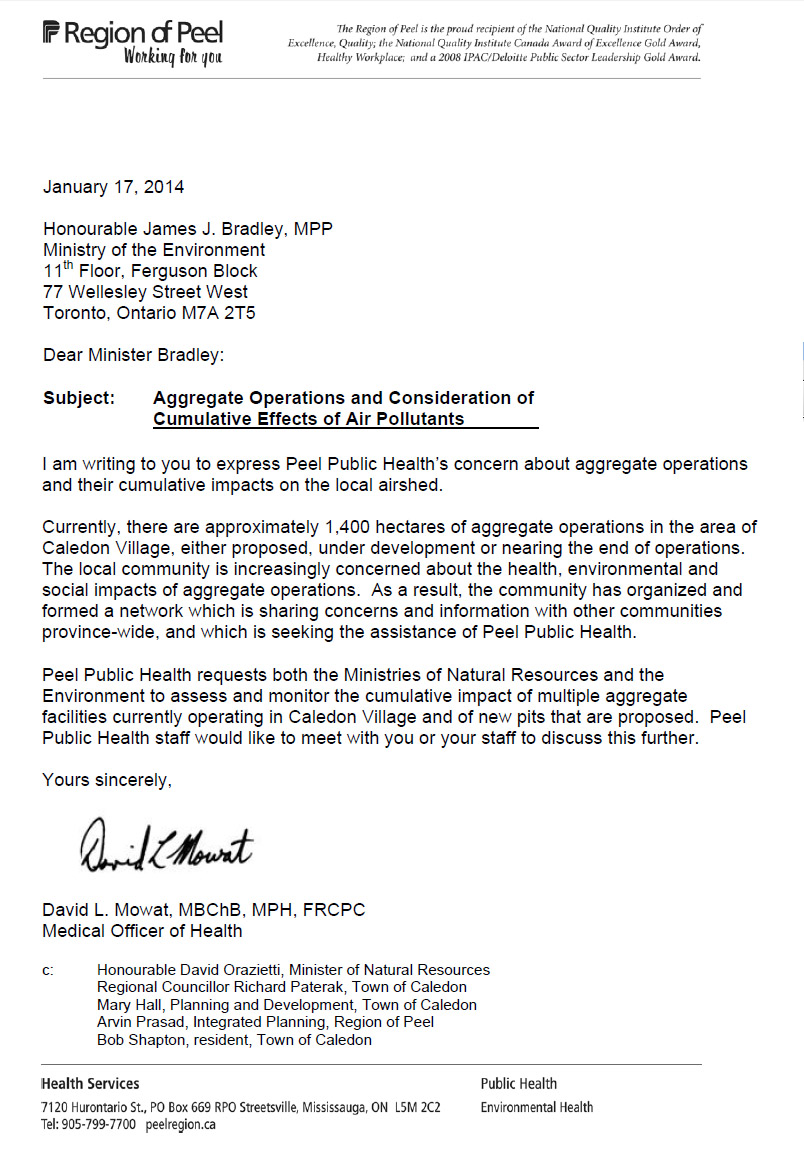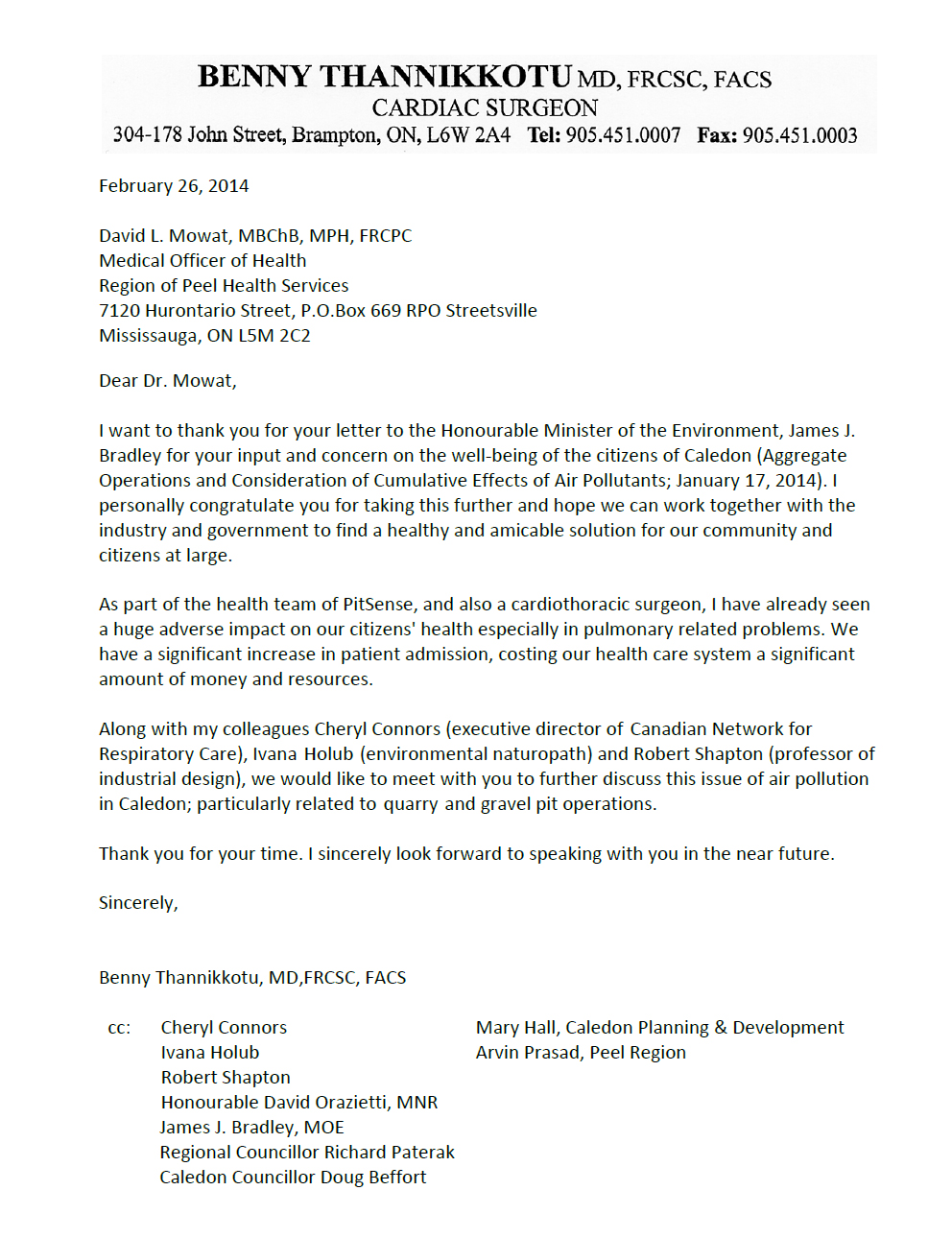PitSense is a community of people organized to respond to proposals for further increases in the number and size of aggregate operations in Caledon.
We are opposed to the continuing 'Domino Effect' growth of open pit mines and quarries in the agricultural and rural residential areas of the Niagara Escarpment and UNESCO World Biosphere Reserve.
Air quality issues are a major concern, both for local area residents and any communities downwind of an operational
pit or quarry. Furthermore, the Fine Particulate Matter from diesel transport affects all areas in proximity to or affected
by haul routes. Rail and ship transport of aggregates are not only more economical than truck transport but also contribute less to air contamination.
Dust from pit and quarry activities that blows off site is often termed nuisance or fugitive dust. The standards of
Ontario’s Aggregate Resources Act (ARA) , Section 3.0 Prescribed Conditions, Subsection 3.1 states “Dust will be mitigated
on site.” The ARA definition of mitigate is: To alleviate, moderate or reduce the severity of impacts. Other definitions
include: To rectify, repair or compensate for impacts, lessen or to try to lessen the seriousness or extent of. They are
not required under the ARA to eliminate dust.
Dust Suppressants: Water spraying… requires frequent applications. CaCl2 and MgCl2, absorb moisture, but are toxic to
plants and can potentially contaminate the aquifer. Oil derivatives pollute and lignin compounds, though safer, wash off.
Facts: Dust or airborne particulate matter (PM) varies in size. Total Suspended Particulate (TSP) refers to dust less than
100 microns in diameter. Large particles tend to settle quickly, smaller more harmful particles can be carried great distances.
Dust is produced from blasting, crushing, screening and stacking operations as well as conveyor belts and loader and truck
transport on site and trucks offsite. Dust is also produced during overburden removal and construction of berms and from
wind blowing over stock piles and across barren pit floors. (Unlike excessive noise, dust has to be mitigated during construction). Dust increases corrosion and is harmful to vegetation.
Fine Particulate Matter, 10 microns or less in diameter (PM 10) can be inhaled and is considered toxic under the Canadian
Environmental Protection Act (CEPA). Smaller respirable particulate matter, (PM 2.5) with a diameter of 2.5 microns or less,
is even more dangerous, lodging deep within the lungs and tissue. There is no biological mechanism for clearing it from the body.
Recent studies show that fine particulates pose a greater danger to our health than better known kinds of air pollution,
such as smog, sulphur dioxide and carbon monoxide. There is incontrovertible evidence that increased PM 10 is related to
increases in cardiopulmonary disease, asthma, bronchitis, emphysema, pneumoconiosis and premature death in those with
pre-existing conditions. The elderly and the young are most affected. Crystalline silica dust is common from processing sand
and gravel and is a known carcinogen. Any dust report should include a specific analysis of crystalline silica content and
dispersion.
Ontario General Air Pollution Regulation: This regulation, revoked and replaced on November 30, 2005 by O. Reg. 419/05,
prescribes standards for permissible air emissions and the modeling requirements to determine compliance at the POI (point of
impingement). An MOE Certificate of Approval is required in order to discharge into the natural environment. This usually
requires a detailed report on all air emissions from a facility including an Emissions Summary Dispersion Modeling (ESDM)
report (based on recent methods from the US EPA).
Canada Wide Standards (CWS) for PM were established in 2000. It is important to note however, that that there is
no “safe” threshold of PM pollution. The “interim” standards are based on risk assessment “balanced” by the cost
of implementation, with the input of “stakeholders”. A recent critical report ”The Air We Breathe”, by David Boyd
(David Suzuki Foundation) recommends more stringent legally binding Canadian air quality standards (similar to the US,
Australia and Europe).
Summary:Dust can kill you. Mitigation measures for pits and quarries are inadequate. Dust studies and instrument
monitoring should be mandatory and include detailed analysis of specific mineral content (eg: silica, mica etc).
MOE allowable PM standards do not go far enough, to ensure clean safe air.
source: Gravel Watch
The area put at risk by the Blueland Farms application is part of the
Escarpment designated as "Escarpment Rural". The Niagara Escarpment Commission website states:
"The Niagara Escarpment Biosphere Reserve also involves a buffer area of
limited resource use and consists of areas designated "Protection" and
"Rural" by the NEP. The area of cooperation (also known as the transition area)
involves the NEP designations of"Urban," "Minor Urban," "Recreation", and
"Mineral Resource" . The cooperation zone is the large outer part of the biosphere
reserve where people live and work, using the natural resources of the area
in a sustainable manner." (emphasis added)
PitSense believes that the words "limited" and "sustainable" are meaningful.
We are calling on our legislators and regulators to pay more heed to these
words when further degradations of our Escarpment Biosphere Reserve are
being proposed.
Fresh air keeps the doctor poor.
.... Danish proverb
Copyright © 2010-2024 PitSense Niagara Escarpment Group Inc.
All rights reserved
A I R Q U A L I T Y
Consultant studies* show that air quality will be negatively affected, not only at the McCormick pit itself but also significantly along the haul route across the neighbouring pits to Hwy.10, north and south on Hwy.10. and East and West along Charleston Sideroad. Property owners along those roads will be subject to the health impacts, not to mention the safety issues and reduced property values.
December 4, 2012 - Cleaner Air May Lengthen Life Spans ... New research shows a link between reductions in air pollution and better life expectancy ... By Jaimie Dalessio, Everyday Health Staff Writer
Continued improvements to air quality across the United States appear to extend life expectancy, new research out of Boston's Harvard School of Public Health (HSPH) indicates. Researchers analyzed 545 U.S. counties over seven years (2000 to 2007) and observed an association between reductions in fine particulate matter and improved life expectancy.
January 17, 2014 - Peel Region Medical Officer of Health Dr. David Mowat wrote to the Ministries of Environment and Natural Resources requesting assessment and monitoring of the cumulative impact of aggregate operations on local air quality. PitSense commends this initiative.
February 27, 2014 - Local Cardiologist responds to Peel Region Medical Officer of Health Dr. David Mowat's letters to the Ministries of Environment and Natural Resources requesting assessment and monitoring of the cumulative impact of aggregate operations on local air quality. PitSense commends this initiative.
^ Click on image to enlarge ^










